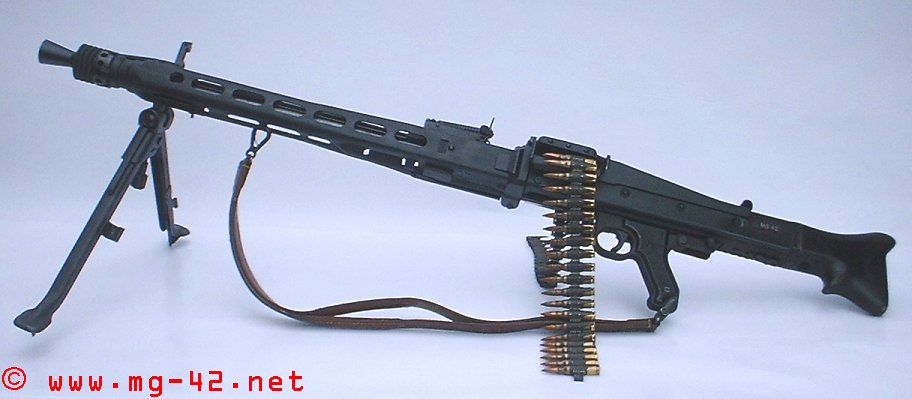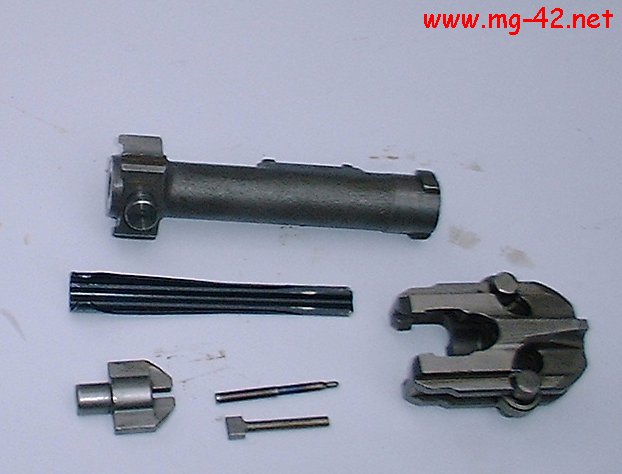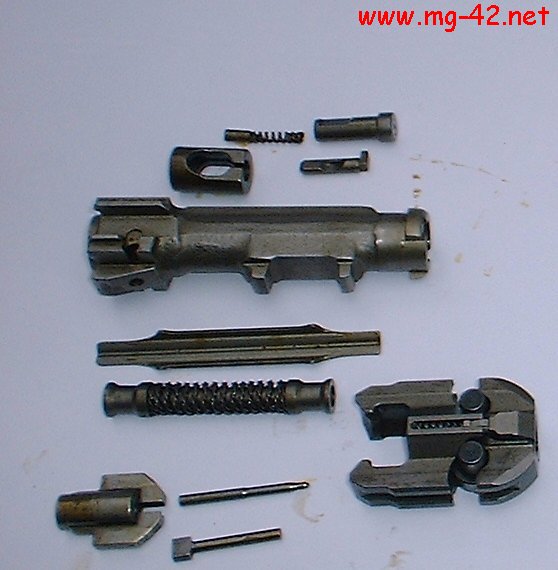|
|

This
beltfed machinegun is still used by
numerous armies around the world, also designated MG3 and MG74.
It is, or has been available in
the following calibers:
7.92x57 mm
(8x57 IS)
7.62x51 mm
6.5x55 mm
7.62x63 mm
(30-06, U.S. T24 experimental
LMG)

Above is the older style bolt
group without a bolt catch found in early 8mm guns.
Below is the current style bolt group with
a bolt catch found in current 7.62 mm guns.
This catch was added to
prevent "out of battery firing" due to a locking harmonics problem. More info
HERE

A brief story of the MG 42
The story of the MG42 starts
with it's predecessor, the MG 34.
| |
The
comparably complicated construction of the MG 34 restricted mass
production, therefore the numbers demanded by the wehrmacht could never be
met. It was soon obvious that a simpler model was needed.
The new
machine gun was to be manufactured from pressed and punched steel parts.
Three
companies were requested to construct a new machinegun using sheet metal
stampings. The proposed construction of the company Metall- und Lackierwarenfabrik
Johannes Grossfuss AG in Döbeln looked promising from the very start. It's
inventor was Dr
Werner Gruner who was a
specialist in the technique of punching and pressing steel. He was sent
into the regular training for machine gunners in the wehrmacht to find out
what a machine gun's characteristics were to be and then went on to design
the MG 42. The MG 34 and the MG 42 are easily discerned even at a
quick glance by their barrel housings: while the MG 34 has a round
housing with many round cooling holes, the MG 42 has a square
housing with oval cooling openings at the left and top side, and a large slit on the right side
for barrel exchange.
The first prototype designated MG 39 was accepted for troop trials
in February 1939; it was refined into the fifth and final prototype, the MG39/41,
and sent into a large combat evaluation involving 1,500 MG 39/41. After
small detail improvements, mass production was started and the weapon was
introduced into the wehrmacht as the MG 42. Total production of the
MG 42 for the German wehrmacht during WW II was 414,964. The weapon
was produced by the companies Mauser
AG
Werke Borsigwalde, Gustloff-Werke in
Suhl, Grossfuss in Döbeln, Maget in Berlin and Steyr in
Vienna.
The weapon was air-cooled and recoil-operated with a short barrel recoil;
the recoil mechanism based on a newly invented- construction of a breech
with rollers. The belted Mauser 7.92 mm ammunition was fed from the left.
The unmatched simplicity, functionality and effectiveness of the design
not only resulted in a an astonishing ruggedness and immunity to the
conditions of front use, it also decreased the amount of resources and raw
material necessary to produce one MG 42 to 27.5 kg; it took only 75 work
hours to complete a MG 42 as opposed to the 150 necessary for the MG 34; the
MG 42 cost only 250 Reichsmark. Even today it is still regarded by many
experts as the best machine gun construction ever.
It had an overall length of 122.0 cm, a barrel of 53.0 cm and weighed 11.6
kg in the role as a light machine gun equipped with the bipod. The bipod,
the same as on the Mg 34, could be mounted to the front or the center of
the gun. In the role as a heavy machine gun it utilized the newly
developed Lafette 42 ("mount") that weighed 20.5 kg. The
MG42's nominal rate of fire was 1500/min; reportedly, this rate varied to
a degree with individual weapons; furthermore, the rate slightly increased
in prolonged bursts. The higher rate of fire led to a decreased barrel
life expectancy when compared with the MG34: the barrel was only good for
between 3,500 to 4,000 rounds. Later, barrels were chrome-plated which
lengthened life expectancy a bit; still, the barrel became hot rather fast
and had to be changed often; the MG42 accounted for this with an even
further simplified barrel change mechanism.
Because of the ruggedness of the MG 42, it was preferred to issue this
weapon to the infantry and rather use the MG 34 in vehicle mounts where
the MG 34 was less exposed to dirt and damage.
With the acute material shortages of 1944 it was deemed necessary to
further simplify to save resources. This resulted in the
MG42V,
also called MG 45, which modified the breech mechanism of the MG42 so that
it didn't completely lock before firing.
The revised locking system was a semi-rigid
roller lock very
similar in design to the later G3 rifles made by H&K. This increased the theoretical
rate of fire even further, the weapon now only weighed 9 kg and - most
importantly -production was simplified and needed only steel of minor
quality. First tests were undertaken in June 1944, but development dragged
on and eventually only ten were ever built.
|
|
Sources:
M.Hofbauer and the
book MG34-MG42 GERMAN UNIVERSAL MACHINEGUNS by Folke Myrvang (ISBN
0-88935-278-X)
|